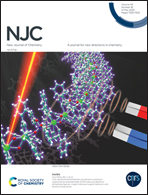An in situ assay of nerve agents enabled by a self-assembled bienzymatic electrochemical biosensor†
Abstract
Nerve agents (NAs) are a group of organophosphorus compounds with acute lethal toxicity, but the knowledge of NA simulants is insufficient to clarify the toxicity of NAs. Herein, we introduce a self-assembled bienzymatic electrochemical biosensor, in which acetylcholinesterase (AChE) and choline oxidase were immobilized to a poly(o-phenylenediamine)-modified Au electrode. This as-presented biosensor is competent in the in situ detection of NAs and in the recording of the inhibition and reactivation processes of AChE. The limit of detection for soman (GD), sarin (GB), VX, and tabun (GA) can reach as low as 2.9, 1.1, 3.1, and 41 nM, respectively. Besides, the in situ characterized inhibition processes are achieved using a one-step protocol, where the inhibition rate constants for GD, GB, VX, and GA were calculated to be 1.36 × 107, 3.9 × 106, 3.2 × 106 and 1.7 × 105 M−1 min−1. We further investigated the reactivation efficiency of oximes against NA-inhibited AChE. HI-6 and obidoxime possess better reactivation capacity for GB- and VX-inhibited AChE. Insights into NA inhibition and reactivation processes with such an electrochemical biosensor may benefit in the better designing of an early detection system with high sensitivity and selectivity for NAs and for understanding poisoning and detoxification of other chemical warfare agents.



 Please wait while we load your content...
Please wait while we load your content...